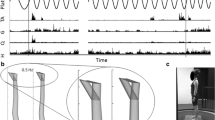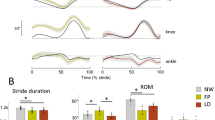Abstract
Infants acquire the ability to roll over from the supine to the prone position, which requires body coordination of multiple degrees of freedom under dynamic interactions with the ground. Although previous studies on infant rolling observed kinematic characteristics, little is known about the kinetic characteristics of body segments in contact with the surface. We measured the ground contact pressure under the arms, legs, head, and proximal body segments using a pressure mat and their displacements using a three-dimensional motion capture system. The data obtained from 17 infants aged 9–10 months indicated that most of them showed 2–4 of 6 highly observed movement patterns, including 1 axial rolling, 2 spinal flexion, and 3 shoulder girdle leading patterns. The arms and legs had small contributions to the ground contact pressure in the axial rolling and spinal flexion patterns. The ipsilateral leg in relation to the rolling direction was involved in supporting the body weight in only 1 shoulder girdle leading pattern. The contralateral leg showed large peak pressure to push on the floor before rolling in 3 shoulder girdle leading patterns. The results indicate that infants can produce multiple rolling-over patterns with different strategies to coordinate their body segments and interact with the floor. The results of the analysis of the movement patterns further suggest that few patterns correspond to those reported in adults. This implies that infants generate unique motor patterns by taking into account their own biomechanical constraints.











Similar content being viewed by others
Availability of data and material
The datasets generated during and/or analyzed during the current study are available from the corresponding author on reasonable request.
References
Adolph KE, Berger SE (2007) Motor development. In: Handbook of child psychology. Wiley, Hoboken, p 2
Adolph KE, Hoch JE, Cole WG (2018) Development (of walking): 15 suggestions. Trends Cognit Sci 22:699–711
Alexander R, Boehme R, Cupps B (1993) Normal development of functional motor skills Therapy Skill Builders, San Antonio, TX
Arnold AJ, Liddy JJ, Harris RC, Claxton LJ (2020) Task-specific adaptations of postural sway in sitting infants. Dev Psychobiol 62:99–106
Bayley N (1993) Bayley scales of infant development. The Psychological Corporation, San Antonio
Bertsch C, Unger H, Winkelmann W, Rosenbaum D (2004) Evaluation of early walking patterns from plantar pressure distribution measurements. First year results of 42 children. Gait Posture 19:235–242
Chen LC, Metcalfe JS, Jeka JJ, Clark JE (2007) Two steps forward and one back: learning to walk affects infants’ sitting posture. Infant Behav Dev 30:16–25
Cordo PJ, Hodges PW, Smith TC, Brumagne S, Gurfinkel VS (2006) Scaling and non-scaling of muscle activity, kinematics, and dynamics in sit-ups with different degrees of difficulty. J Electromyogr Kinesiol 16:506–521
Deffeyes JE, Harbourne RT, Kyvelidou A, Stuberg WA, Stergiou N (2009) Nonlinear analysis of sitting postural sway indicates developmental delay in infants. Clin Biomech 24:564–570
Dusing SC, Kyvelidou A, Mercer VS, Stergiou N (2009) Infants born preterm exhibit different patterns of center-of-pressure movement than infants born at full term. Phys Ther 89:1354–1362
Fallang B, Hadders-Algra M (2005) Postural behavior in children born preterm. Neural Plast 12:175–182
Gesell A, Thompson H (1934) Infant behavior: its genesis and growth. McGraw-Hill Book Company, New York
Hadders-Algra M (2018) Early human motor development: from variation to the ability to vary and adapt. Neurosci Biobehav Rev 90:411–427
Hadders-Algra M, Brogren E, Forssberg H (1996) Ontogeny of postural adjustments during sitting in infancy: variation, selection and modulation. J Physiol 493:273–288
Hallemans A, D’Août K, De Clercq D, Aerts P (2003) Pressure distribution patterns under the feet of new walkers: the first two months of independent walking. Foot Ankle Int 24:444–453
Harbourne RT, Stergiou N (2003) Nonlinear analysis of the development of sitting postural control. Dev Psychobiol 42:368–377
Ivanenko YP, Dominici N, Cappellini G, Dan B, Cheron G, Lacquaniti F (2004) Development of pendulum mechanism and kinematic coordination from the first unsupported steps in toddlers. J Exp Biol 207:3797–3810
Kafri M, Dickstein R (2005) Activation of selected frontal trunk and extremities muscles during rolling from supine to side lying in healthy subjects and in post-stroke hemiparetic patients. Neurol Rehabil 20:125–131
Kanemaru N, Watanabe H, Taga G (2012) Increasing selectivity of interlimb coordination during spontaneous movements in 2- to 4-month-old infants. Exp Brain Res 218:49–61
Kato M, Watanabe H, Taga G (2013) Diversity and changeability of infant movements in a novel environment. J Mot Learn Dev 1:79–88
Kato M, Hirashima M, Oohashi H, Watanabe H, Taga G (2014) Decomposition of spontaneous movements of infants as combinations of limb synergies. Exp Brain Res 232:2919–2930
Kobayashi Y, Watanabe H, Taga G (2016) Movement patterns of limb coordination in infant rolling. Exp Brain Res 234:3433–3445
Kokkoni E, Haworth JL, Harbourne RT, Stergiou N, Kyvelidou A (2017) Infant sitting postural control appears robust across changes in surface context. Somatosens Mot Res 34:265–272
Kyvelidou A, Harbourne RT, Willett SL, Stergiou N (2013) Sitting postural control in infants with typical development, motor delay, or cerebral palsy. Pediatr Phys Ther 25:46–51
McGraw MB (1941) Neural maturation of the infant as exemplified in the righting reflex, or rolling from a dorsal to a prone position. J Pediatr 18:385–394
Metcalfe JS, Chen LC, Chang TY, McDowell K, Jeka JJ, Clark JE (2005a) The temporal organization of posture across the first year of independent walking. Exp Brain Res 161:405–416
Metcalfe JS, Chen LC, Chang TY, McDowell K, Jeka JJ, Clark JE (2005b) Development of somatosensory-motor integration: An event-related analysis of infant posture in the first 9 months of independent walking. Dev Psychobiol 46:19–35
Nishizawa Y, Fujita T, Matsuoka K, Nakagawa H (2006) Contact pressure distribution features in Down syndrome infants in supine and prone positions, analyzed by photoelastic methods. Pediatr Int 48:484–488
Nitta O, Yanagisawa K, Takaku N, Honjou Y (2003) Kinematic patterns of rolling over in children with cerebral palsy. J Phys Ther Sci 15:25–31
Ohmura Y, Gima H, Watanabe H, Taga G, Kuniyoshi Y (2016) Developmental changes in intralimb coordination during spontaneous movements of human infants from 2 to 3 months of age. Exp Brain Res 234:2179–2188
Piper MC, Darrah J (1994) Motor assessment of the Developing Infant. W. B Saunders Company, Philadelphia
Prechtl HR (1984) Continuity and change in early neural development. Clin Dev Med 94:1–15
Price C, McClymont J, Hashmi F, Morrison SC, Nester C (2018) Development of the infant foot as a load bearing structure: Study protocol for a longitudinal evaluation (the Small Steps study). J Foot Ankle Res 11:33
Richter RR, VanSant AF, Newton RA (1989) Description of adult rolling movements and hypothesis of developmental sequences. Phys Ther 69:63–71
Rihar A, Mihelj M, Pašič J, Kolar J, Munih M (2014) Infant trunk posture and arm movement assessment using pressure mattress, inertial and magnetic measurement units (IMUs). J Neuroeng Rehabil 11:133
Schneider K, Zernicke RF (1992) Mass, center of mass, and moment of inertia estimates for infant limb segments. J Biomech 25:145–148
Sekiya N, Takahashi M (2004) Kinematic and kinetic analysis of rolling motion in normal Adults. J Jpn Phys Ther Assoc 7:1–6
Shirley MM (1931) The first two years: a study of twenty-five babies. Vol 1 Postural and locomotor development. The University of Mnnesota Press, Minneapolis
Sylos-Labini F, Magnani S, Cappellini G, La Scaleia V, Fabiano A, Picone S, Paolillo P, Di Paolo A, Lacquaniti F, Ivanenko Y (2017) Foot placement characteristics and plantar pressure distribution patterns during stepping on ground in neonates. Front Physiol 8:784
Teitelbaum P, Teitelbaum O, Nye J, Fryman J, Maurer RG (1998) Movement analysis in infancy may be useful for early diagnosis of autism. Proc Natl Acad Sci U S A 95:13982–13987
Teitelbaum O, Benton T, Shah PK, Prince A, Kelly JL, Teitelbaum P (2004) Eshkol-Wachman movement notation in diagnosis: the early detection of Asperger’s syndrome. Proc Natl Acad Sci U S A 101:11909–11914
Thelen E (1995) Motor development. A new synthesis. Am Psychol 50:79–95
Touwen BCL (1976) Neurological development in infancy. Clin Dev Med 58. Spastics International Medical Publications, London
VanSant AF (1990) Life-span development in functional tasks. Phys Ther 70:788–798
von Hofsten C (2004) An action perspective on motor development. Trends Cogn Sci 8:266–272
Watanabe H, Taga G (2006) General to specific development of movement patterns and memory for contingency between actions and events in young infants. Infant Behav Dev 29:402–422
Watanabe H, Taga G (2011) Initial-state dependency of learning in young infants. Hum Mov Sci 30:125–142
Watanabe H, Homae F, Taga G (2011) Developmental emergence of self-referential and inhibition mechanisms of body movements underling felicitous behaviors. J Exp Psychol Hum Percept Perform 37:1157–1173
Winter DA (2009) Biomechanics and motor control of human movement, 4th edn. John Wiley & Sons Inc, Hoboken
Yamamoto N (2011) Longitudinal observation of the acquisition process for rolling-over movement in infancy. Jpn J Dev Psychol 22:261–273 (in Japanese, English abstract)
Yozu A, Haga N, Tojima M, Zhang Y, Sumitani M, Otake Y (2013) Vertical peak ground force in human infant crawling. Gait Posture 37:293–295
Acknowledgements
The authors wish to thank Kayo Sato, Keiko Hirano, Yoshiko Koda and Nobuhiko Haga for their assistance with data acquisition. This work was partly supported by JSPS Grant-in-Aid for Scientific Research Number 17KT0135 (to H. W.) and 16H06525 (to G.T.).
Author information
Authors and Affiliations
Corresponding author
Ethics declarations
Conflict of interest
The authors declare that there are no conflict of interest, financial or otherwise.
Additional information
Communicated by Francesco Lacquaniti.
Publisher's Note
Springer Nature remains neutral with regard to jurisdictional claims in published maps and institutional affiliations.
Rights and permissions
About this article
Cite this article
Kobayashi, Y., Yozu, A., Watanabe, H. et al. Multiple patterns of infant rolling in limb coordination and ground contact pressure. Exp Brain Res 239, 2887–2904 (2021). https://doi.org/10.1007/s00221-021-06174-w
Received:
Accepted:
Published:
Issue Date:
DOI: https://doi.org/10.1007/s00221-021-06174-w




